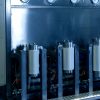All the different phases during the entire extraction process have a single important purpose: to verticalize the product. In this way the extractive matrices can increase, even exponentially their economic-commercial value, these matrices can be material of little industrial interest, or even useless material, such as production waste. This last type of material is a problem for many companies, due to the (often heavy) disposal costs. By extracting with CO2 in the supercritical phase, it is possible to obtain multiple products, each with high added value, and they are easily inserted in cosmetics, food, or feed field. Starting from the pre-treatments, (grinding, drying or pelletizing), passing through the actual extraction, (with the use of co-solvent, to increase the polarity of the solvent, if it is necessary) up to the post-processing treatments (purification with activated carbon, centrifugation, winterization), the product continues to increase its value, and this can only be an advantage for the companies that ask us a feasibility study, also considering the absence of solvents after extraction.
An example of production can be chia oil. At first glance, the raw material appears as small seeds with black, grey, and odorless color. It undergoes a short pre-treatment, which consists of drying followed by grinding, useful for increasing the final yield of the oil. The extraction takes place later, a well-tested procedure, with variables set for maximum efficiency. At this point, the solvent-free production batch is ready for some control analyzes, such as microbiological ones. All production takes place in a HACCP certified work environment, maintained by skilled workers in the sector, subject to maintaining strict rules of general hygiene. Once the analyzes have been passed, the oil is ready for trade and can be sold as a bio, solvent free, gluten free and also safe from a chemical and biological point of view. Its value can be further increased, through a micronization process, methodology with which the oil is atomised and crystallized, transforming it into a particulate having dimensions of a few µm and stable at ambient temperature; two fundamental values for today’s demands of pharmaceutical companies.
The company is, therefore, able, thanks to the versatility of its systems, to also develop products for third parties: from the R&D phase. to the production of high activity intermediates for food, nutraceutical, pharmaceutical, cosmetic, and cosmeceutical sector Exenia is, therefore, able to offer an articulated and specialized offer.


